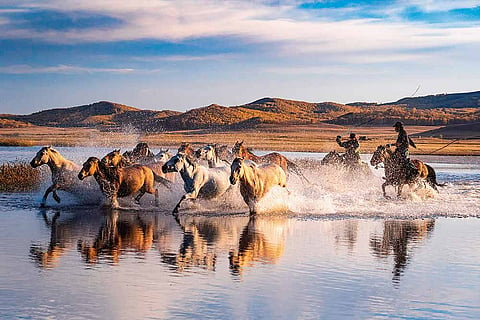- Destinations
- Experiences
- Stay
- What's new
- Editor’s Picks
- Responsible Tourism
- CampaignsCampaigns
- Subscribe

"It was an extraordinary landscape—pale yellow, under a blue sky—extraordinary because it was not a desert, but rather the largest pasture imaginable; here and there a herd of horses, here and there a camel, or a man, or a tent. It was inhabited, but with a sparseness that was impressive."
—Paul Theroux, American novelist and travel writer
Imagine swathes of golden grasslands stretching towards a horizon painted an endless cerulean. This is the territory of the nomads, where herds of horses dot the landscape. A lone Bactrian camel is silhouetted against the setting sun while wisps of smoke rise from a felt-covered yurt, a testament to a way of life endured for millennia. This is Mongolia, the birthplace of Genghis Khan. Here, the wind sings across the boundless steppes, echoing the hoofbeats of Khan's empire. Join us as we delve deeper into this land of stark beauty, encountering the traditions, resilience, and spirit that define the heart of this East Asian country.
Beneath a vast Mongolian sky, cattle graze on a field hardened by winter. The scene reflects the resilience of life in this harsh yet beautiful land.
Clad in a deel, the traditional robe of the Mongolian people, a woman sits proudly on her Bactrian camel. This enduring partnership symbolises the resilience of nomadic life.
A yurt—a portable tent made of a lattice of flexible poles covered in felt or other fabric—stands under a boundless Mongolian sky. This symbol of the nomadic way of life showcases the deep connection Mongolians have with their land.
In Mongolia's western steppes, a Kazakh eagle hunter embodies a centuries-old tradition. These skilled individuals partner with golden eagles to hunt during winter, a testament to the bond between humans and semi-wild animals.
This train route, a branch of the iconic Trans-Siberian Railway, connects Mongolia to Ulan-Ude in Russia, offering a chance to experience the rhythm of daily life and the scenery of this country.
Ulaanbaatar's Winter Palace or the Bogd Khan Museum was once the residence of the last Mongolian emperor. It now houses a fascinating collection of artefacts, offering a glimpse into a bygone era.
Saishang Old Street in Hohhot, Inner Mongolia's capital, provides a window into the region's heritage. Visitors meander along streets flanked by picturesque Ming and Qing-style architecture, delving into the origins of this city.
Standing tall on the banks of the Tuul River, the Genghis Khan Equestrian Statue reigns supreme as the world's tallest equestrian monument.
A young Mongolian couple, adorned in 13th-century garb, stands within a Ulaanbaatar temple.
Sun-baked cliffs in Tsagaan Suvarga
A spectacle of Bayanzag's Flaming Cliffs, where the Gobi Desert ignites in a blaze of colour
Know Before You Go
Visa: There are two types of visas for Indians travelling to Mongolia: urgent and standard. The urgent visa costs INR 2,800 and takes two days to process, while the normal visa costs INR 400 and takes five days to process.
Currency: Mongolian Tugrik Exchange Rate: INR 1 = MNT 41.4
Getting There: Direct flights from India to Mongolia are not available. The most optimal, economical, and efficient route to reach Mongolia is through Hong Kong. A roundtrip flight costs approximately INR 75,000.
Getting Around Mongolia: In Mongolia, Toyota Landcruisers and the durable UAZ-452 are the preferred 4WDs for grasslands. Provincial travel includes large buses, while local minivans provide inter-province transport. Western Mongolia, known for its eagle hunters, is best reached by plane.
Food: In Mongolia, traditional eateries known as guanz offer authentic local dishes like buuz (steamed mutton dumplings) and tsuivan (fried noodles) at affordable prices. Coffee costs INR 160-250, khuushuur (fried mutton pancakes) INR 80, and dinner for two INR 1,600-5,000. A pint of beer at Ulaanbaatar pubs typically costs around INR 250.
Accommodation: Accommodation options in Ulaanbaatar vary in price. Dorm beds typically range from INR 800-1,600, while basic rooms for two can cost between INR 5,000-12,500. For a more unique experience, a night in a ger homestay (a felt tent) starts from INR 3,200. Bringing your tent is another cost-effective option.
Pro Tip: In Mongolia, tour costs decrease per person when more passengers share a 4WD vehicle. Rugged vans can accommodate up to six passengers and are favoured by budget operators. Also, insurance premiums make opting for a car with a driver more cost-effective. Some hotels offer free airport pick-up for guests staying a few days, while the cheapest way to reach the city is via shuttle bus, priced at around a sixth of a taxi ride.
